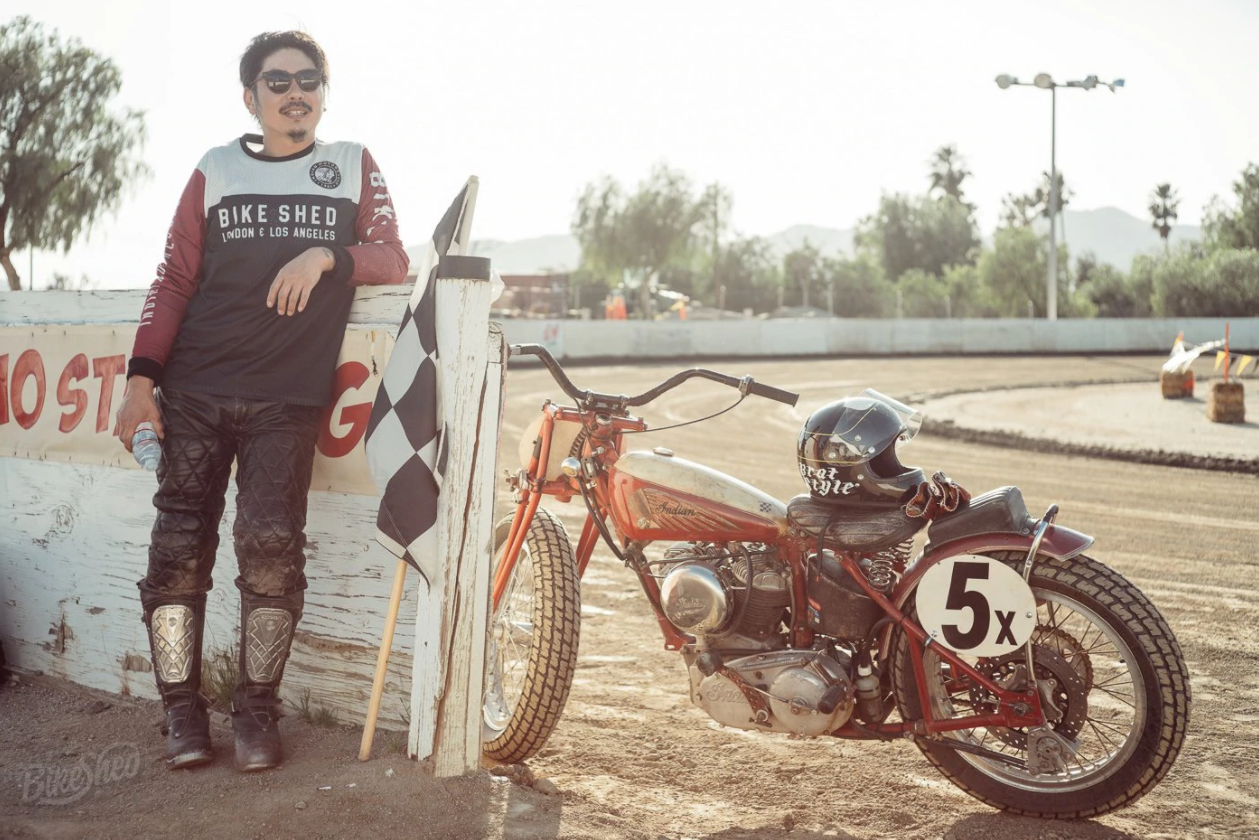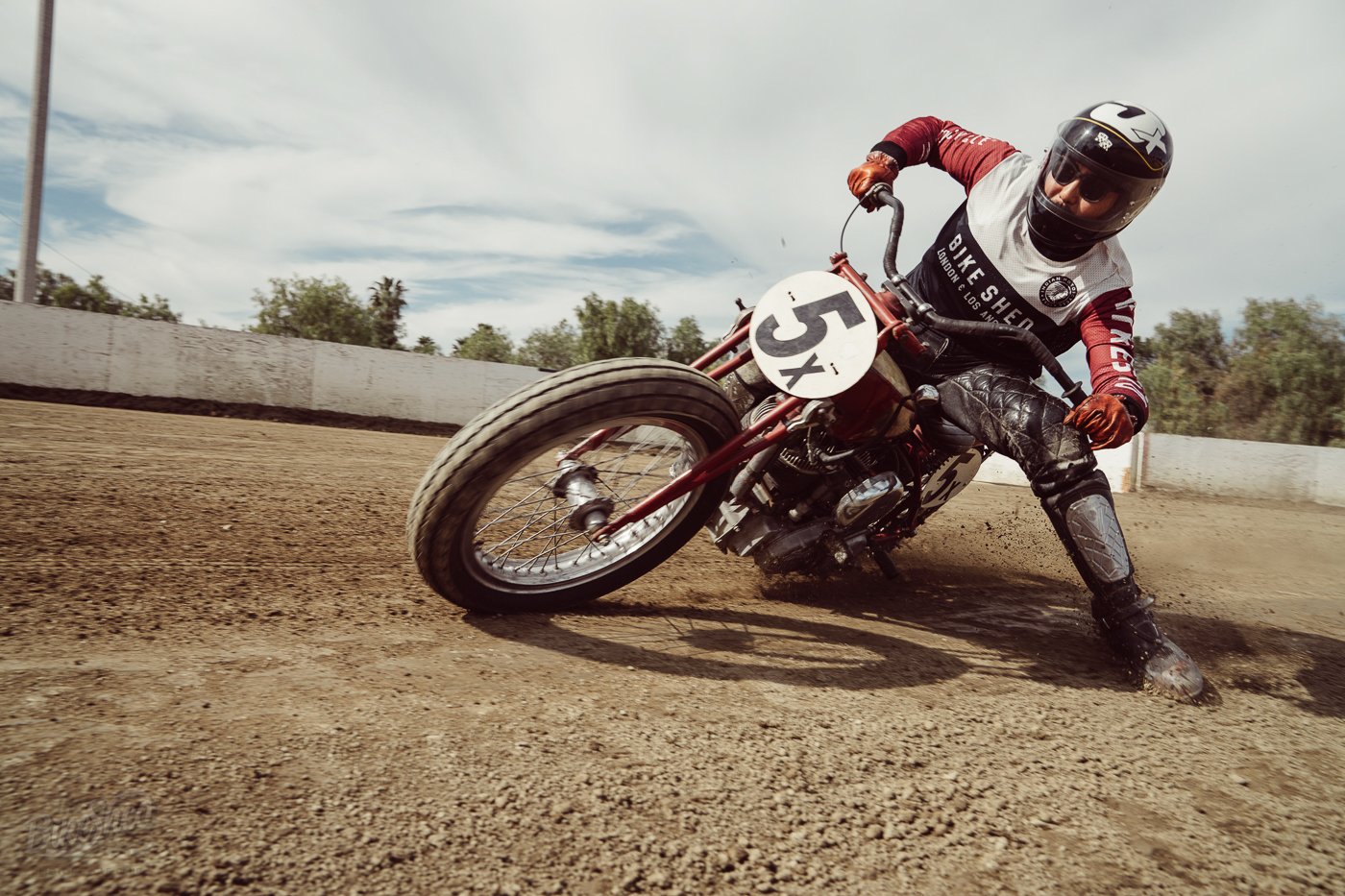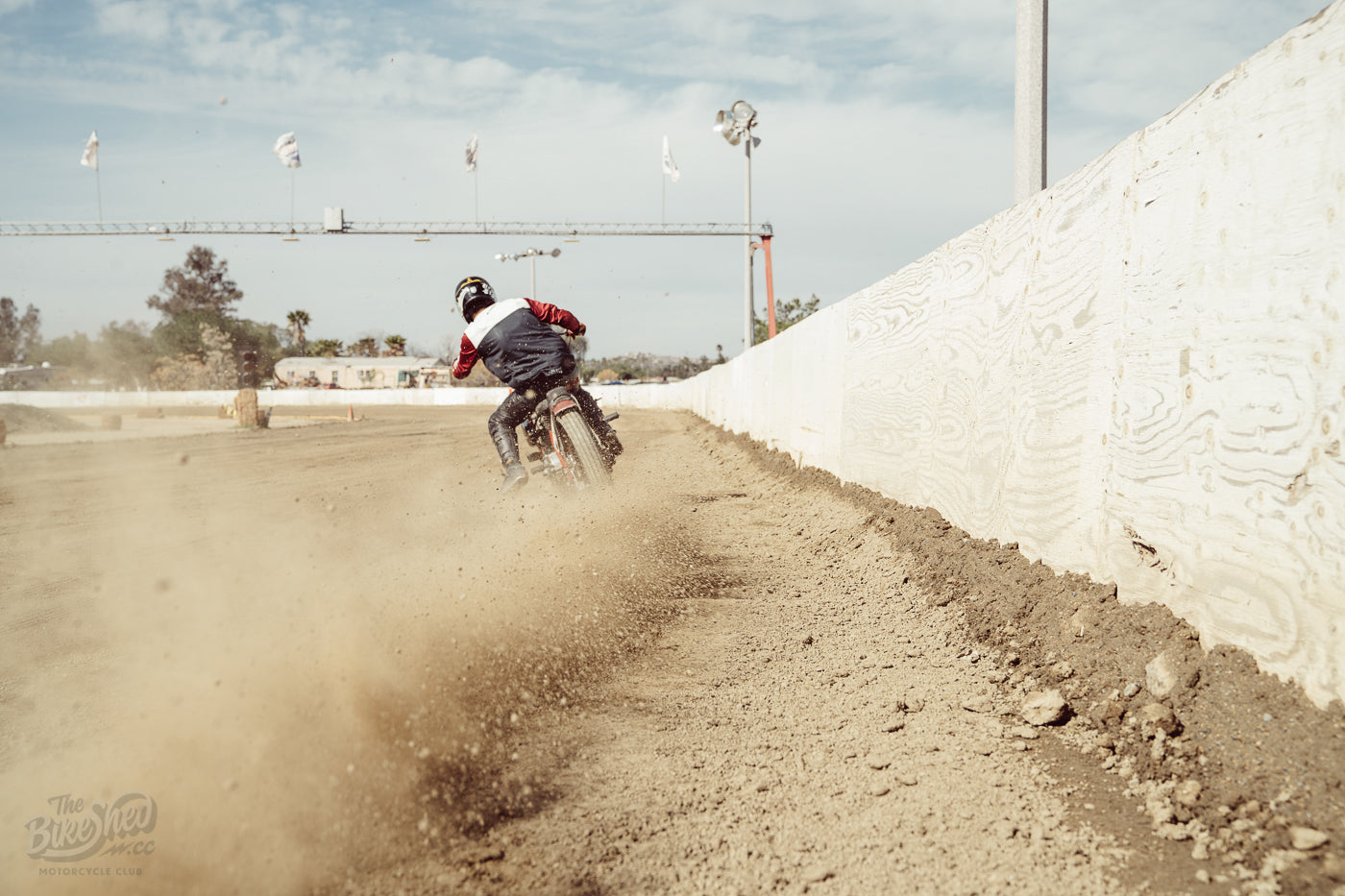Go Takamine: The Father of Brat Style
By Bike Shed Membership - 01 Apr 22

 He stands at the edge of a dirt oval in the Southern California desert with no one to race but his shadow. Straight out of the pits his form is impeccable, his riding style inimitable, and even though he is on a 93-year-old Indian Scout, he is so incredibly fast.
He stands at the edge of a dirt oval in the Southern California desert with no one to race but his shadow. Straight out of the pits his form is impeccable, his riding style inimitable, and even though he is on a 93-year-old Indian Scout, he is so incredibly fast.  When he reaches the end of the straight his inside leg stretches supernatural, and his steel hot shoe carves into the freshly groomed dirt. He stays off the gas for a moment and slides through a staccato of backfires, and then wrings open the throttle wrapped thick with cloth tape, and yanks back on the tank-mounted shifter, and crosses the start-finish line with his body tucked against the bike. He turns lap after lap until his muscles ache and forearms throb, but even then he doesn’t stop, racing through the last minutes of daylight. When he pulls off his helmet, the sweat on his skin glistens under stadium lights, and his eyes shine bright and boyish.
When he reaches the end of the straight his inside leg stretches supernatural, and his steel hot shoe carves into the freshly groomed dirt. He stays off the gas for a moment and slides through a staccato of backfires, and then wrings open the throttle wrapped thick with cloth tape, and yanks back on the tank-mounted shifter, and crosses the start-finish line with his body tucked against the bike. He turns lap after lap until his muscles ache and forearms throb, but even then he doesn’t stop, racing through the last minutes of daylight. When he pulls off his helmet, the sweat on his skin glistens under stadium lights, and his eyes shine bright and boyish.  Go Takamine is one of the most well-respected custom motorcycle builders in the world. He is a fearsome racer on the vintage flat-track circuit, and the shop he opened when he was 23 years old, Brat Style, became so popular that the term “brat” now describes an entire genre of bikes. His talents are diverse and remarkable, his creativity is unbound, and his adorably soft-spoken charm is as infectious as his cool is undeniable. Six years ago Go and his wife, Masumi, moved from Tokyo, Japan, to Long Beach, California, to open the second location of Brat Style, and now Go is living out the dreams of his youth.
Go Takamine is one of the most well-respected custom motorcycle builders in the world. He is a fearsome racer on the vintage flat-track circuit, and the shop he opened when he was 23 years old, Brat Style, became so popular that the term “brat” now describes an entire genre of bikes. His talents are diverse and remarkable, his creativity is unbound, and his adorably soft-spoken charm is as infectious as his cool is undeniable. Six years ago Go and his wife, Masumi, moved from Tokyo, Japan, to Long Beach, California, to open the second location of Brat Style, and now Go is living out the dreams of his youth.  Born and raised on the island of Okinawa, Go spent hours staring through a window in his middle school classroom, watching guys on dirt bikes rip around a disused military base until the police chased them away. “I just wanted to ride with them,” Go says, “and that was my inspiration to get a motorcycle, the desire to ride around with those guys on that dirt field.” At 16, Go saved up enough money to buy his first bike, a 50cc scooter. He says, “I went to school and after school, I went to work, and after that I went for a ride on my motorcycle. I repeated the same routine every day.” He started hanging out at a local motorcycle shop called Friends, where he learned basic maintenance and slowly started customizing.
Born and raised on the island of Okinawa, Go spent hours staring through a window in his middle school classroom, watching guys on dirt bikes rip around a disused military base until the police chased them away. “I just wanted to ride with them,” Go says, “and that was my inspiration to get a motorcycle, the desire to ride around with those guys on that dirt field.” At 16, Go saved up enough money to buy his first bike, a 50cc scooter. He says, “I went to school and after school, I went to work, and after that I went for a ride on my motorcycle. I repeated the same routine every day.” He started hanging out at a local motorcycle shop called Friends, where he learned basic maintenance and slowly started customizing.  After he graduated from high school in 1993, Go moved from Okinawa to Tokyo, where he got a job at an automotive body shop, doing simple fabrication work for truck drivers. After two years he moved to a paint shop, where he started spraying motorcycle tanks and selling them on the side. Go says, “Painting was kind of how I made a name for myself before starting Brat Style.” He began racing motocross and flat track, although there weren’t many events in Japan at the time, and he rented on a shop space in Ueno—so small that a compact car couldn’t fit in it—and busted knuckles on his first frame-off build, a Yamaha TW. “I did not think of having a company when I first started, but I already had a sign: ‘Bratstyle.’ I wanted a name that represented youth and freedom, so I came up with ‘Bratstyle,’ which means ‘freewheeling,’ or to feel young and free, even as I got older.”
After he graduated from high school in 1993, Go moved from Okinawa to Tokyo, where he got a job at an automotive body shop, doing simple fabrication work for truck drivers. After two years he moved to a paint shop, where he started spraying motorcycle tanks and selling them on the side. Go says, “Painting was kind of how I made a name for myself before starting Brat Style.” He began racing motocross and flat track, although there weren’t many events in Japan at the time, and he rented on a shop space in Ueno—so small that a compact car couldn’t fit in it—and busted knuckles on his first frame-off build, a Yamaha TW. “I did not think of having a company when I first started, but I already had a sign: ‘Bratstyle.’ I wanted a name that represented youth and freedom, so I came up with ‘Bratstyle,’ which means ‘freewheeling,’ or to feel young and free, even as I got older.”  After a couple of years splitting time between his shop and the paint booth, Go dedicated himself to the craft of motorcycle building. He says, “For the first five years I was broke, I had nobody working for me, and I did not have the money or the space for proper machines, but I had many friends around me, and they helped me out, and every day we got together and partied. I still keep in touch with all of them.” It wasn’t easy to make a living, but the jobs kept coming, and Go’s reputation grew, and eventually the work became too much for one man to handle.
After a couple of years splitting time between his shop and the paint booth, Go dedicated himself to the craft of motorcycle building. He says, “For the first five years I was broke, I had nobody working for me, and I did not have the money or the space for proper machines, but I had many friends around me, and they helped me out, and every day we got together and partied. I still keep in touch with all of them.” It wasn’t easy to make a living, but the jobs kept coming, and Go’s reputation grew, and eventually the work became too much for one man to handle.  Nine years later Go packed up to start anew in the States with his wife, Masumi, who he met in 2012 at a vintage motorcycle gathering. Masumi says, “We both worried about coming to the U.S. but we had always wanted to move here, and once we decided we were coming, it was quick, even though we were worried about what would happen to the shop in Tokyo.” The Takamines rented an 8,000-square-foot machine shop on the outskirts of Long Beach, where they are the sole employees, and after moving to America Go realized that he couldn’t keep building and selling the same sort of motorcycles that he had in Japan. “Those were too cheap and low budget, and I realized that they would not match the style of Americans. I’d always wanted to work on vintage American motorcycles, so I tried it.”
Nine years later Go packed up to start anew in the States with his wife, Masumi, who he met in 2012 at a vintage motorcycle gathering. Masumi says, “We both worried about coming to the U.S. but we had always wanted to move here, and once we decided we were coming, it was quick, even though we were worried about what would happen to the shop in Tokyo.” The Takamines rented an 8,000-square-foot machine shop on the outskirts of Long Beach, where they are the sole employees, and after moving to America Go realized that he couldn’t keep building and selling the same sort of motorcycles that he had in Japan. “Those were too cheap and low budget, and I realized that they would not match the style of Americans. I’d always wanted to work on vintage American motorcycles, so I tried it.”  In 2015 he built his first Indian custom for Born Free 7—the “Chout,” a ’41 Scout with an oversized Chief motor—and he took home the “Best Indian” award. Go says the Chout “showed him the new style of Brat Style,” and that after building it he felt free to express himself in totally new ways. He started buying up rusty, unloved bikes and oil-stained boxes of obscure parts, and now Go has built over 20 vintage Indians and sold many of them to buyers around the globe. He acquired a ‘39 Scout from a friend and turned it into a tank-shift, flat-track bike that he “crashed and broke countless times,” and he and Masumi spent almost every summer weekend in the paddock of a dirt track somewhere in California, and it soon became obvious to everyone watching that the Takamines would be regulars on the podium.
In 2015 he built his first Indian custom for Born Free 7—the “Chout,” a ’41 Scout with an oversized Chief motor—and he took home the “Best Indian” award. Go says the Chout “showed him the new style of Brat Style,” and that after building it he felt free to express himself in totally new ways. He started buying up rusty, unloved bikes and oil-stained boxes of obscure parts, and now Go has built over 20 vintage Indians and sold many of them to buyers around the globe. He acquired a ‘39 Scout from a friend and turned it into a tank-shift, flat-track bike that he “crashed and broke countless times,” and he and Masumi spent almost every summer weekend in the paddock of a dirt track somewhere in California, and it soon became obvious to everyone watching that the Takamines would be regulars on the podium. 
 Go owes much of his racing success to his late friend and mentor Kenneth “Smokey” Elford, who passed away in 2019. In his early life Smokey was a pioneer in flat-track racing, piloting a ’35 Indian Scout he built himself, and as he got older he honed his skills by building and tuning Scout trackers with racing icon Bob Nichols. Smokey was a big, burly man with a long white beard who enjoyed wearing bright red suspenders, and he ran his shop out of his one-car garage in Long Beach, and stored motorcycles in his front room because he needed the space. “I miss all of Smokey,” Go says. “He taught me how to build motorcycles that fast and durable and hold together throughout a race. To me it’s most important to enjoy the race, and if I win, I’ll be even happier.”
Go owes much of his racing success to his late friend and mentor Kenneth “Smokey” Elford, who passed away in 2019. In his early life Smokey was a pioneer in flat-track racing, piloting a ’35 Indian Scout he built himself, and as he got older he honed his skills by building and tuning Scout trackers with racing icon Bob Nichols. Smokey was a big, burly man with a long white beard who enjoyed wearing bright red suspenders, and he ran his shop out of his one-car garage in Long Beach, and stored motorcycles in his front room because he needed the space. “I miss all of Smokey,” Go says. “He taught me how to build motorcycles that fast and durable and hold together throughout a race. To me it’s most important to enjoy the race, and if I win, I’ll be even happier.”  A special thanks to Misa Matsushima for translating our interview with Go Takamine.
A special thanks to Misa Matsushima for translating our interview with Go Takamine.
